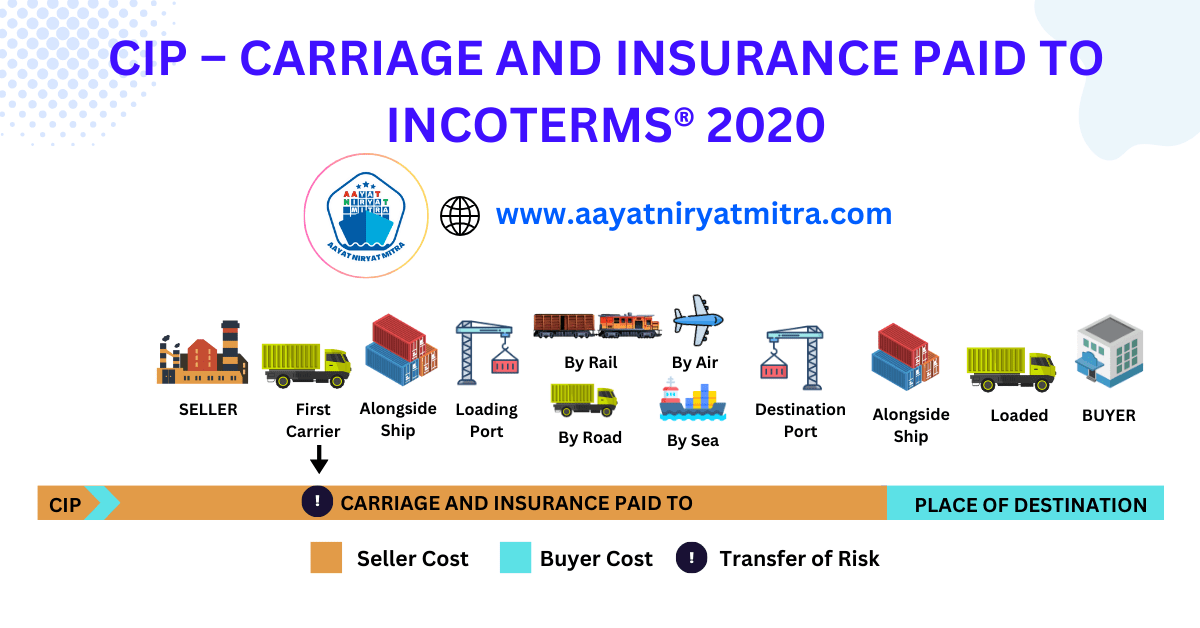Explore the world of CIP Incoterms® 2020. Learn how this trade terminology can help you speed up international transactions and protect your shipments with insurance.
Introduction:
Choosing the correct trade conditions is critical to a smooth and successful transaction in the world of international trade. CIP – Carriage and Insurance Paid To, as defined in Incoterms® 2020, is one such collection of words. In this detailed overview, we will look at what CIP Incoterms are, how they work, and why they are important in global business.
Understanding CIP Incoterms®
What Are CIP Incoterms?
CIP, which stands for “Carriage and Insurance Paid To,” is a set of rules outlined in Incoterms® 2020 that is used all over the world. These phrases define the obligations of buyers and sellers in terms of cost, risk, and the delivery of products to a specified location. The seller is responsible for arranging and paying for transportation, including carriage and insurance, to deliver the goods to the agreed-upon location.
How Does CIP Benefit Buyers?
- Risk Mitigation: CIP transfers risk from the buyer to the seller until the items are delivered to the specified location. This means that if the products are damaged or lost in transit, the seller is responsible for filing an insurance claim.
- Simplified Logistics: Buyers benefit from the simplified logistics of CIP because the seller arranges shipping and insurance, assuring a trouble-free delivery process.
- Cost Clarity: CIP gives purchasers cost calculation transparency, making it easier to budget for overseas transactions.
How Does CIP Benefit Sellers?
- Competitive Advantage: Sellers who use CIP may gain a competitive advantage by providing buyers with comprehensive delivery and insurance solutions.
- Risk Management: Sellers can manage the risk of the shipping by obtaining adequate insurance coverage.
- Global access: Because CIP is adaptable and compatible with numerous forms of transportation, vendors can access a global market.
Is CIP Suitable for Small Businesses?
Yes, CIP Incoterms are appropriate for all sizes of firms, including small businesses. Clarity in cost and risk allocation advantages both small enterprises and major organizations involved in international trade.
What Documents Are Associated with CIP?
Commercial invoices, bills of lading, insurance certificates, and any other paperwork required by the buyer or importing nation are common documents linked with CIP transactions.
Can CIP Be Combined with Other Incoterms?
When necessary, CIP words can be combined with other Incoterms, particularly in complex multinational transactions. However, it is critical to precisely outline each party’s responsibilities in the contract.
Example of CIP
Exporting Onion from Nashik to Dubai – CIP Incoterms® 2020
Step 1: Find a buyer
The first step is to find a buyer of onions in Dubai. You can search online or contact your local chamber of commerce for recommendations.
Step 2: Agree on the terms of the sale
Once you have found a buyer, you need to agree on the terms of the sale, including the price, quantity, quality, and delivery terms. Be sure to specify that you want to use CIP Incoterms® 2020.
Step 3: Arrange payment
Once you have agreed to the terms of the sale, you need to arrange payment. You can do this by bank transfer, wire transfer, or credit card.
Step 4: Arrange shipping
The seller will arrange the shipping of the goods to JNPT Port. The seller will be responsible for all costs and risks associated with transporting the goods to JNPT Port, including loading, carriage, insurance, and unloading.
Step 5: Purchase insurance
You should purchase insurance to cover the goods in transit. This will protect you financially in the event that the goods are lost or damaged.
Step 6: Prepare the export documentation
You will need to prepare the following export documentation:
- Commercial invoice
- Packing list
- Bill of lading
- Certificate of origin
- Other documentation required by the customs authorities of the importing country
Step 7: Clear customs
You will need to clear the goods through customs at JNPT Port. You will need to provide the customs authorities with the necessary documentation, such as the commercial invoice, packing list, and bill of lading.
Step 8: Load the goods onto the vessel
Once the goods have cleared customs, you will need to load them onto the vessel that will be transporting them to Dubai.
Step 9: Notify the buyer
Once the goods have been loaded onto the vessel, you need to notify the buyer. You should provide the buyer with the bill of lading and other relevant documentation.
Step 10: Receive payment
Once the goods have arrived in Dubai and the buyer has cleared them through customs, you will receive payment.
Additional considerations
- Be sure to get everything in writing, including the terms of the sale, the payment terms, and the shipping instructions.
- It is a good idea to have the goods inspected by a third-party inspector before they are shipped. This will help to ensure that the goods are of the agreed quality and quantity.
- You should also purchase insurance to cover the goods in transit. This will protect you financially if the goods are lost or damaged.
Example
You are an exporter of onions in India. You have an order for 100 MT of onions from a buyer in Dubai. You agree on a price of USD 500 per ton and delivery terms of CIP Dubai Port.
You arrange payment from the buyer via bank transfer. You contact a shipping company and arrange for the onions to be shipped from JNPT Port to Dubai Port.
You purchase insurance to cover the onions in transit.
You prepare the necessary export documentation and clear the goods through customs at JNPT Port.
You load the onions onto the vessel and notify the buyer.
The onions arrive in Dubai and the buyer clears them through customs. You receive payment from the buyer.
FAQs Carriage and Insurance Paid To (CIP)
-
Q: What is CIP Carriage and Insurance Paid To Incoterms® 2020?
Ans: CIP is a short form of Carriage and Insurance Paid To. It is an Incoterms rule that requires the seller to deliver the products to the first carrier at the point of shipping and to insure the items until they are unloaded at the destination.
-
Q: What are the risks and benefits of CIP for sellers?
Ans: CIP is an Incoterms rule that favors sellers. The seller’s key risks are that they must deliver the items to the first carrier and provide insurance coverage. The seller, on the other hand, has the advantage of being able to control the transit of the products and choosing the insurance firm.
-
Q: What are the risks and benefits of CIP for buyers?
Ans: CIP is an Incoterms regulation that favors buyers. The biggest risk for the buyer is that they are responsible for clearing the products for import as well as paying all charges and duties from the point of shipment onward. The buyer, on the other hand, has the advantage of having the items delivered to their destination as well as having insurance coverage for the goods until they are unloaded.
-
Q: What are the key obligations of the seller under CIP?
Ans: The seller’s key obligations under CIP are to:
1. Deliver the goods to the first carrier at the place of shipment.
2. Provide insurance coverage for the goods until they are unloaded at the place of destination.
3. Clear the goods for export.
4. Pay all costs and duties up to the place of shipment. -
Q: What are the key obligations of the buyer under CIP?
Ans: The buyer’s key obligations under CIP are to:
1. Pay for the goods and insurance.
2. Take delivery of the goods at the place of destination.
3. Clear the goods for import.
4. Pay all costs and duties from the place of shipment onwards. -
Q: What are some examples of goods that are commonly shipped under CIP?
Ans: CIP is a popular Incoterms regulation for transporting a wide range of commodities, such as:
1. Machinery and equipment
2. Automotive parts
3. Electronics
4. Consumer goods
5. Food and agricultural products
Conclusion:
Finally, CIP – Carriage and Insurance Paid To Incoterms® 2020 is critical in international trading. They provide a structured framework for cost allocation, risk management, and efficient delivery of commodities to specified destinations. Understanding and employing CIP Incoterms can considerably help your international trade efforts, whether you are a buyer seeking risk avoidance or a seller seeking a competitive edge.
If you are considering using CIP Incoterms® 2020, it is important to consult with a qualified trade professional to understand your specific needs and responsibilities.
If you discover an error in the “CIP – Carriage and Insurance Paid To Incoterms®2020: A Comprehensive Guide” information provided to us, please notify us immediately via the comment box and email; if the information provided by you is correct, We will change it.
If you enjoyed this article, please share it with your friends. Please visit Aayat Niryat Mitra for more information on this and other topics. Thank you for stopping by.

